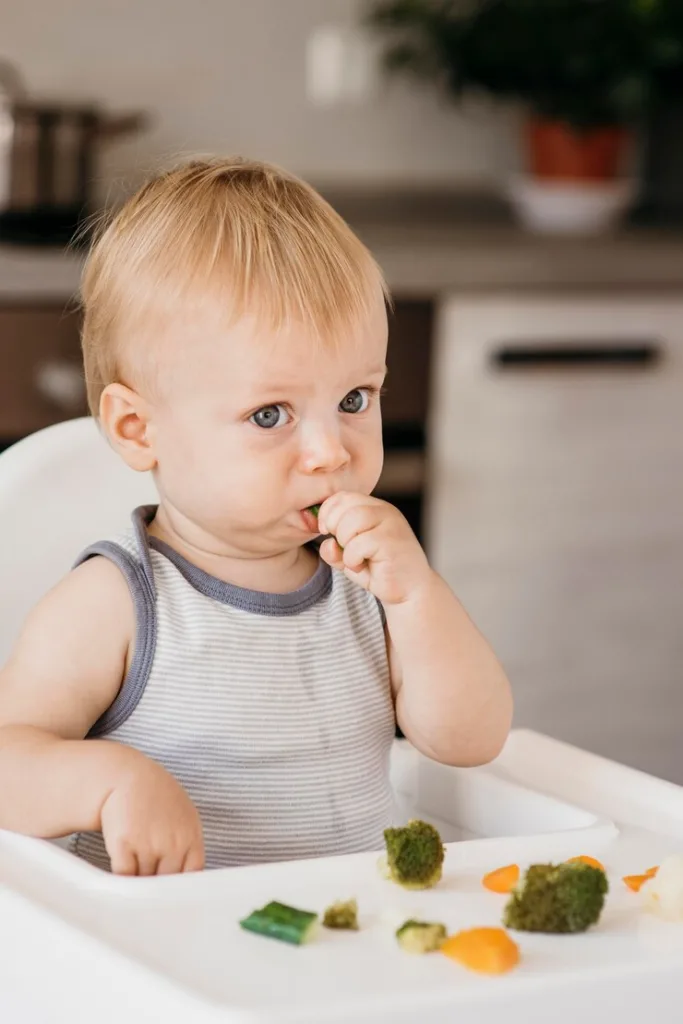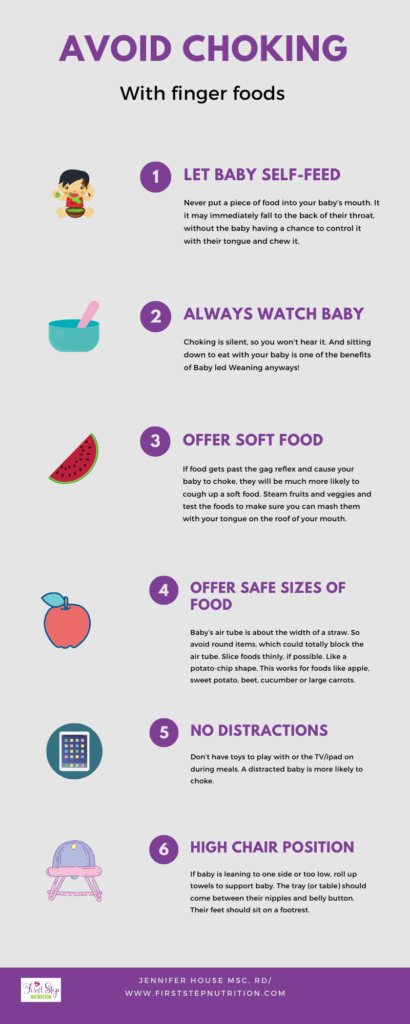The Ultimate Guide To Solid Food Weaning Starting 6 months old
Looking to introduce solid food weaning to your little munchkin? Say hello to Baby led weaning (BLW), or solid food weaning. It is a feeding approach that has been making waves! With BLW, your baby becomes their own little chef, feeding themselves right from the start. This ultimate guide to BLW will help you safely on your way. No more spoon-feeding drama!
When should you consider BLW? or solid food weaning? The American Academy of Pediatrics suggests that once your baby has doubled their birth weight, can hold their head up confidently, shows curiosity about food, and can maneuver food in their mouths, they’re ready for this foodie adventure.

BLW or solid food weaning is all about letting your baby take the reins and explore food at their own pace. It’s natural, responsive, and helps develop healthy eating habits, waving goodbye to picky eating tantrums!
Ready to dive into the juicy details? We’ve got you covered with a comprehensive guide to BLW or also known as solid food weaning. From getting started to the top first foods for your little one, you’ll find all you need right here. We’ll also address those common concerns and dig into the evidence supporting this baby-led approach.
Let the mealtime fun begin!
What exactly is BLW?
Baby-led weaning (BLW) or also known as solid food weaning is a genius feeding approach where little ones get to embrace their inner foodie by feeding themselves cute little finger-sized bites of tasty goodness. This method, popularized by the legendary Gill Rapley in her book ‘Baby Led Weaning: The Essential Guide to Introducing Solid Food’, opens up a whole new world of textures and flavors for babies to explore and enjoy. Not only does BLW or also known as solid food weaning promote independence and self-regulation in eating, but it also turns mealtime into a delightful adventure.
Now, before you dive into the wonderful world of BLW, there are a few things to consider. One of them is the dreaded choking hazard. But fear not! By offering foods or solid food weaning that are appropriately sized and textured, closely supervising your little munchkin while they eat, and being ready to act swiftly if they start to choke, you can keep the risks at bay and enjoy the BLW journey with peace of mind.

Now let’s address the elephant in the room – some parents worry that their little gourmands might not be getting enough nutrition if they’re not devouring boatloads of food right off the bat. But here’s the scoop: breastmilk or formula will remain the main dish on the menu for the first few months of solid food escapades. As your precious bundle of joy becomes more comfortable with the whole eating shebang, their intake will gradually ramp up.
So there you have it, folks! BLW or also known as solid food weaning is a fabulously fun and fulfilling way to introduce solids to your little cutie pie. Get ready to embark on a culinary adventure that will dazzle your baby’s taste buds and foster their love for good food from the very beginning.

Getting Started
When it comes to introducing solid food weaning to your little one using a self-feeding approach, timing is key. Wait until your baby has doubled their birth weight and shows signs of being able to handle and manipulate food in their mouth – usually around 6 months. Remember, breast milk or formula will still be the main source of nutrition during the first year, with solids simply complementing those milk feeds.
Now, let’s talk highchair essentials. You’ll want a sturdy, stable highchair that allows your baby to sit up straight and provides foot support. This will keep them secure and cosy while chomping away.
Oh, and speaking of chomping, did you know that introducing potentially allergenic foods for babies earlier on might help reduce allergy risks down the road? Yep! Think peanuts, tree nuts, fish, shellfish, soy, and dairy. Just introduce these foods one at a time, watch out for any potential allergic reactions, and you’re good to go!
Food Recommendations
Let’s dive into some amazing first-food options for baby-led weaning or also known as solid food weaning! How about some roasted sweet potato wedges, succulent roasted apple wedges, juicy melon slices, or tantalizing avocado spears? These options are not only easy to handle but also provide a variety of textures and flavors that will surely excite your baby’s taste buds.
Now, let’s talk about what foods to avoid during this exciting journey. Stay away from anything that’s hard, sticky, or crunchy. And, don’t forget to steer clear of added salt, cow’s milk, added sugar, and honey. Let’s keep those little tummies happy and healthy!

But wait, what about introducing allergenic foods? Well, you can totally do that during baby-led weaning, as long as there’s no family history of food allergies. Some examples of potentially allergenic foods include peanuts, tree nuts, eggs, fish, and shellfish. Remember, introduce these foods one at a time and be on the lookout for any signs of an allergic reaction, such as hives, swelling, or difficulty breathing.
So, there you have it! By providing a variety of soft finger-size food pieces and introducing allergenic foods cautiously, you’re setting the stage for a well-rounded and balanced diet for your little one during the self-feeding process. Happy exploring, little foodie!
FAQ Ultimate Guide to Solid Food Weaning
Q: What is Baby Led Weaning (BLW)?
A: Baby Led Weaning (BLW) or also known as solid food weaning is an approach to introducing solid foods to babies where they are allowed to feed themselves with finger foods instead of being spoon-fed purees.
Q: When can I start baby-led weaning?
A: It is generally recommended to start baby-led weaning or also known as solid food weaning around 6 months of age when your baby is sitting up independently and showing signs of readiness for solid foods.
Q: What are the benefits of baby-led weaning?
A: Baby-led weaning or also known as solid food weaning has several benefits, including promoting self-feeding skills, developing hand-eye coordination, encouraging a wide variety of foods, and allowing babies to explore different tastes and textures.
Q: Can I still give my baby purees while practicing baby-led weaning?
A: Yes, you can still offer your baby purees while practicing baby-led weaning or also known as solid food weaning. The key is to let your baby take the lead and choose what and how much to eat.
Q: What are the best first foods to start baby-led weaning?
A: Some popular first foods for baby-led weaning include soft fruits and vegetables like avocado, banana, and steamed carrots, as well as strips of cooked meats and grains like toast or pasta.
Q: How do I make sure my baby is safe while practicing baby-led weaning?
A: To ensure your baby’s safety during baby-led weaning, always supervise meal times, offer age-appropriate finger foods that are soft and easy to chew, and avoid foods that pose choking hazards such as whole grapes or nuts.
Q: How do I know if my baby is ready for baby-led weaning?
A: Your baby may be ready for baby-led weaning if they can sit up unsupported, have good head control, show interest in solid foods, and can pick up and bring objects to their mouth.
Q: Are there any specific weaning recipes for baby-led weaning?
A: There are many weaning recipes available for baby-led weaning, but it’s important to remember that the focus is on offering a variety of foods in their natural form. You can find recipe ideas in baby-led weaning cookbooks or online resources.
Q: Can I still breastfeed or formula-feed my baby while practicing baby-led weaning?
A: Yes, you can continue to breastfeed or formula-feed your baby alongside practicing baby-led weaning. Breast milk or formula should still be the main source of nutrition during the first year.
Q: How do I let my baby take the lead in baby-led weaning?
A: In baby-led weaning, you let your baby lead the way by allowing them to choose what and how much to eat. You provide a variety of age-appropriate finger foods and let your baby explore and feed themselves at their own pace.







